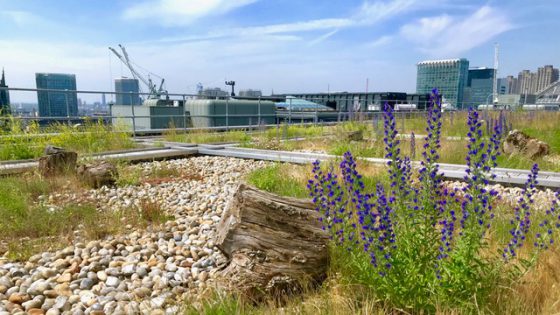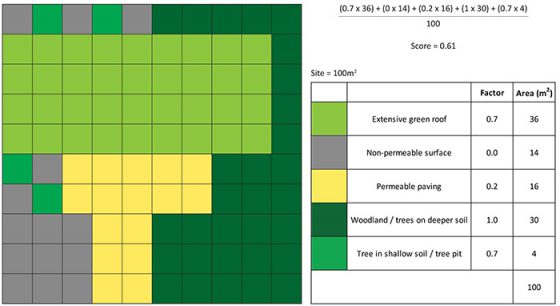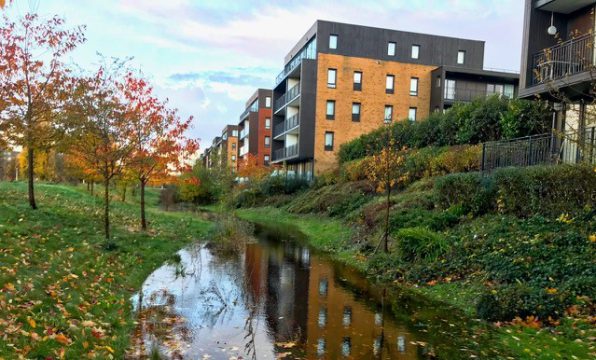With London’s increasing population putting pressure on the city’s natural environment and existing green spaces, the Urban Greening Factor (UGF) has a key role to play in ensuring green infrastructure is taken into consideration as part of a development.
The population of London is growing and current land use policy favours taller buildings and increased density. A denser, more highly populated city will result in significant additional pressures on London’s existing green spaces and natural environment. The existing parks and open spaces, as well as semi-natural habitats associated with the River Thames, railway corridors and road verges, private gardens, street trees and green roofs and walls are all examples of Green Infrastructure. There is a growing awareness and evidence base for the multiple benefits of green infrastructure in addition to the habitat it inherently provides to wildlife, including wellbeing of London residents and its role to alleviate the affects of climate change. In July 2017 The Ecology Consultancy, in collaboration with the Green Infrastructure Consultancy and Temple, published the Urban Greening Factor for London Report. The Urban Greening Factor is a scoring system to quantify the value of different types of green infrastructure being created as part of a development. The UGF works by attributing a score to various landscaping elements such as trees, green roofs and permeable paving. Zero is the lowest score, given to impermeable surfaces like asphalt and 1, the highest, given to natural vegetation on deep soils. An overall score is calculated for the whole site and a target can be set (typically 0.4 or 0.5 depending on the setting and ambitions for greening). The UGF is a relatively straightforward and inexpensive process. The simplified diagram below demonstrates how the scoring systems works (sourced from the City of Southampton).
In July 2017 The Ecology Consultancy, in collaboration with the Green Infrastructure Consultancy and Temple, published the Urban Greening Factor for London Report. The Urban Greening Factor is a scoring system to quantify the value of different types of green infrastructure being created as part of a development. The UGF works by attributing a score to various landscaping elements such as trees, green roofs and permeable paving. Zero is the lowest score, given to impermeable surfaces like asphalt and 1, the highest, given to natural vegetation on deep soils. An overall score is calculated for the whole site and a target can be set (typically 0.4 or 0.5 depending on the setting and ambitions for greening). The UGF is a relatively straightforward and inexpensive process. The simplified diagram below demonstrates how the scoring systems works (sourced from the City of Southampton).
 The Greater London Authority (GLA) has incorporated the Urban Greening Factor into the draft New London Plan. The recommended metric has been provided and targets have been set for the extent and functionality of greenspace within new residential and commercial developments (Policy G5).
Similar schemes have already been implemented in several cities including Berlin, Seattle and Helsinki, and have seen an increase in the amount and functionality of green infrastructure.
The urban greening factor is not about protecting existing assets but is about ensuring new development provides suitable levels of green infrastructure which can be tailored to local circumstances by each of the London Planning Authorities. For example, authorities with lower levels of tree cover can award more points for the planting of trees, or where drainage is an issue, emphasis can be placed on rain gardens and other SuDS features.
The Greater London Authority (GLA) has incorporated the Urban Greening Factor into the draft New London Plan. The recommended metric has been provided and targets have been set for the extent and functionality of greenspace within new residential and commercial developments (Policy G5).
Similar schemes have already been implemented in several cities including Berlin, Seattle and Helsinki, and have seen an increase in the amount and functionality of green infrastructure.
The urban greening factor is not about protecting existing assets but is about ensuring new development provides suitable levels of green infrastructure which can be tailored to local circumstances by each of the London Planning Authorities. For example, authorities with lower levels of tree cover can award more points for the planting of trees, or where drainage is an issue, emphasis can be placed on rain gardens and other SuDS features.
 If you are interested in learning more, The Ecology Consultancy and the Green Infrastructure Consultancy offer CPDs which can be focused on assessments including the Urban Greening Factor, BREEAM, Biodiversity Net Gain and GREENPASS.at. We also offer CPD relating to ecological surveys, including seasonality and constraints to planning applications.
Images © Dusty Gedge, GIC
If you are interested in learning more, The Ecology Consultancy and the Green Infrastructure Consultancy offer CPDs which can be focused on assessments including the Urban Greening Factor, BREEAM, Biodiversity Net Gain and GREENPASS.at. We also offer CPD relating to ecological surveys, including seasonality and constraints to planning applications.
Images © Dusty Gedge, GIC



